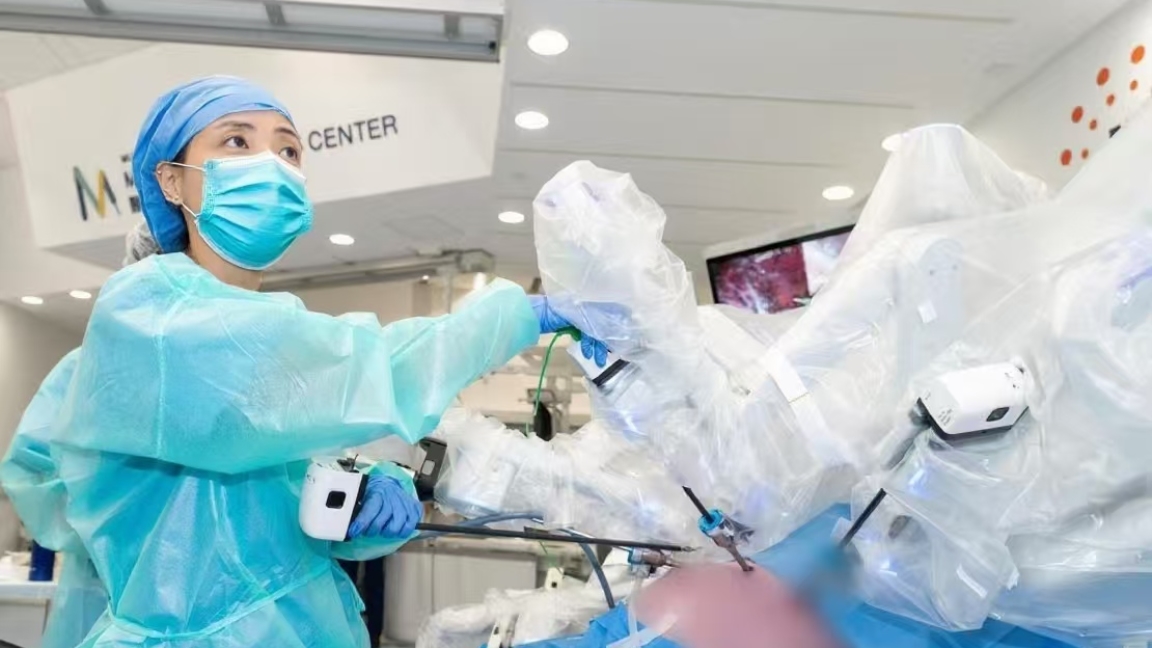
[China Tech] is a column dedicated to the innovations reshaping China – and, inevitably, the world. From cutting-edge AI labs and next-gen robotics to homegrown apps that redefine daily life, we explore the breakthroughs that emerge from the country's relentless drive for technological dominance. Some are game-changers, others cautionary tales, but all offer a glimpse into the future as it's being built, at breakneck speed, in China.
An innovative robotic surgery involving medical teams from Shanghai, Hong Kong and London was successfully completed recently, testing the possibility of super long-distance surgery as well as the quality of China-made medical equipment.
It also testified to the stability, accuracy and multi-region adaptability of domestic-developed robotic surgical systems, showcasing the feasibility of highly efficient surgery cooperation between regions and countries, local officials said.
The surgery room and surgery object were in Hong Kong while medical teams in Shanghai's Renji Hospital and London's Royal Marsden Hospital led the remote surgery in turn, while the robotic arms in Hong Kong conducted the operation as experts from the Chinese University Hong Kong School of Medicine in the surgery room offered monitoring and support at the scene to ensure smooth progress and safety.
The equipment was a robotic surgical system developed by a Shenzhen-based company.
![[China Tech] Robotics-assisted devices are boosting clinical practice in Shanghai](https://obj.shine.cn/files/2025/07/18/25407c10-4ad1-42c5-9e14-6a59ec28d30c_0.jpg)
Medical teams from Shanghai (front), Hong Kong (right at back) and London (left at back) participate in the same long-distance robotic surgery using China-made surgical system.
![[China Tech] Robotics-assisted devices are boosting clinical practice in Shanghai](https://obj.shine.cn/files/2025/07/18/15e2ef45-2f62-4c20-8eea-131fe69a46a6_0.jpg)
Dr Zhang Zizhen from Renji Hospital operates the system in Shanghai, while the robotic arms in Hong Kong perform the operation.
"It was a very meaningful surgery, which offered the same surgical view for medical teams in the three places and realize closed-loop practice. The cross-border and cross-time zone experts were able to achieve seamless operation and connection. All the images, operation response and surgical views were the same for the three teams to ensure safety and continuity of the surgery," said Dr Wang Zheng, vice president of Renji Hospital.
"It was as if medical experts from the three places were working in the exact same surgery room. This case provides precious experiences for similar surgeries in the future, as we also discussed the key technologies and suggested room for improvement in the remote cooperation."
Wang said the case provides a reference for remote robotic surgery for grassroots medical facilities, where patients needn't go all the way to big cities for surgery but can receive it in hospitals in their hometown.
Robotic surgery has become one of the major methods in clinical practice. Compared with traditional human surgery, it has a better surgical outcome, quicker recovery and lower relapse.
"China-made surgical systems have been developing quickly and are almost in line with products from the West. The use and promotion of China-made devices can further boost domestic innovation and help slash medical costs," Zhang observed.
![[China Tech] Robotics-assisted devices are boosting clinical practice in Shanghai](https://obj.shine.cn/files/2025/07/18/9875bb3f-c39d-4837-bbd3-935b29caa9ef_0.jpg)
Doctors in the operation room in Hong Kong monitor the process.
In addition to boosting domestic innovation, local hospitals are eager to introduce the most advanced robotic system from abroad.
Shanghai General Hospital has introduced a robotics-assisted bronchoscopy system, which can reach deep into the lungs for biopsies, offering a minimally invasive alternative to transthoracic needle biopsy while maximizing diagnostic yield for earlier, more definitive results.
This Johnson & Johnson MedTech Monarch system was displayed at the China International Import Expo. It is another example of the CIIE's spill-over effects, industry insiders said.
![[China Tech] Robotics-assisted devices are boosting clinical practice in Shanghai](https://obj.shine.cn/files/2025/07/19/03ecdc8e-476d-4fe1-95ca-a59951fbd6fa_0.jpg)
The robotic system can be operated with a handheld controller as the physician sits, stands or moves around the patient.
Lung cancer is the top cancer killer in the world and is also the most prevalent and most deadly cancer in China, which reports over 1 million new cases and 733,000 death cases annually.
Most patients in China are diagnosed with the disease in the terminal stage, missing the best treatment opportunity. If the cancer is detected and treated early about 77 to 92 percent patients can survive for over five years, while the rate is only 10 to 36 percent for patients in the terminal stage.
"Early screening and precise diagnosis are key for lung cancer prevention and control. But many early lesion and some lung nodules are very small and located in places difficult for traditional bronchoscope to reach as it depends on doctors' hands and fingers," said Dr Fan Jiang, director of the hospital's thoracic surgery department. "But the invasive percutaneous puncture for biopsy carries a high risk for complications and gives rise to anxiety and fear among patients, some of whom, therefore, refuse such practice.
"This innovative robotics-assisted bronchoscopy system uses intelligent technology, making the process akin to playing an electronic game as doctors can operate the controller to guide the robotic pipes to accurately reach the lesion for biopsy and even conduct ablation. Robotics can significantly improve the patient experience because they can get a more definitive diagnosis through one exam. It can improve the efficiency of early lung cancer detection."

